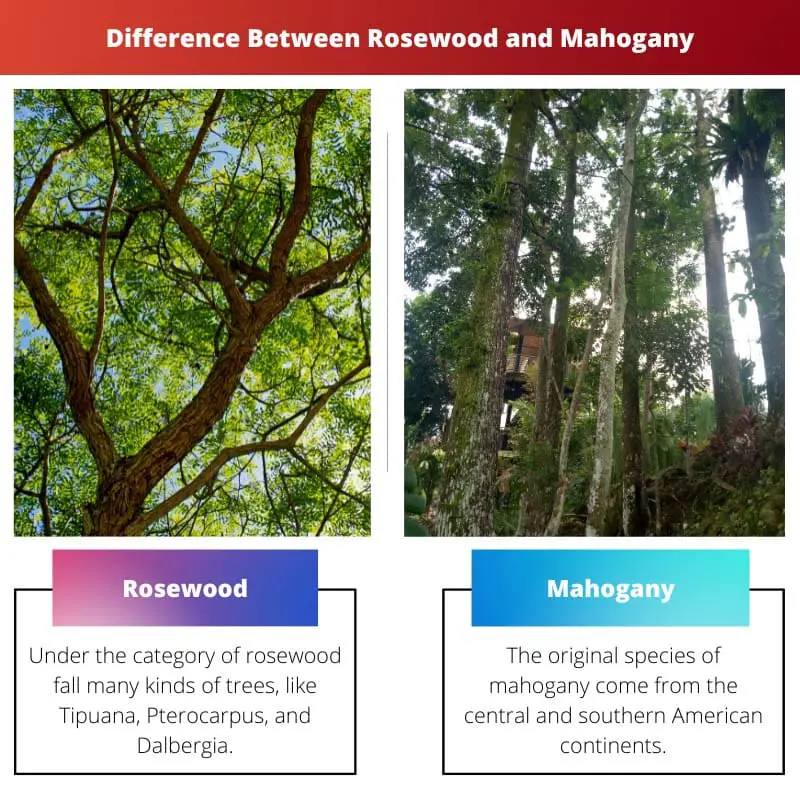Rosewood and mahogany both fall under the category of hardwood and are widely used in crafting furniture, essentials, and different types of instruments.
However, it does not depend on the color or essence of the wood that a piece of furniture is made of, but both the visual and technical factors should be taken into account.
There are many differences between rosewood and mahogany trees that may help the user decide what he or she wants to go with.
Key Takeaways
- Rosewood is denser and harder than mahogany, resulting in better resonance and sustain in musical instruments.
- Mahogany is reddish-brown, while rosewood varies from dark brown to reddish-purple.
- Rosewood tends to be more expensive than mahogany due to scarcity and stricter regulations on harvesting.
Rosewood vs Mahogany
Rosewood is known for its unique, expensive, and distinct grain patterns, with rich reddish-brown or dark brown colors. Mahogany has a more uniform color, ranging from light to deep reddish-brown. Rosewood is more durable than mahogany, with higher resistance to wear, decay, and insects.

Rosewood trees are mainly found in the central and South American continents, Africa, and different parts of southern Asia. The three main species of rosewood trees are Tipuana, Pterocarpus, and Dalbergia.
Because of the sweet essence of these trees, they have been named rosewood. Mahogany trees are highly strong and durable, and that is why it is mostly preferred by craftsmen.
The original species of mahogany trees comes from the central and South American continent. Unlike rosewood trees, the seeds of mahogany trees are straight and fine and not enclosed.
Comparison Table
| Parameters of Comparison | Rosewood | Mahogany |
|---|---|---|
| Origin | Rosewood trees are mainly found in the Central and South American continents, Africa, and different parts of southern Asia. | Mahogany trees are only found in the central and South American continents. |
| Price | Rosewood trees are highly expensive. | Mahogany trees are less expensive than rosewood trees. |
| Seed | Rosewood trees have seeds that are enclosed. | But the seeds of mahogany trees are open, straight, and fine |
| Color | Rosewood trees have a very deep dark brown color. | Will be neat trees have a pink issue that slowly transforms into a reddish tone of color. |
| Production | Rosewood trees have become rare but are still in good production. | Mahogany trees have become highly extinct due to high demands. |
What is Rosewood?
Under the category of rosewood fall many kinds of trees, like Tipuana, Pterocarpus, and Dalbergia. This type of wood is not soft in texture but basically hardwood.
These kinds of trees are mostly found in the central and southern American continents, Africa, and different parts of southern Asia. It takes years to become a full-grown tree and is extremely valuable.
Like other hardwood trees, rosewood trees also shed their leaves annually. One might wonder why these trees are named in such a way.
It is due to the idea that when trees get old, they smell rich and fragrant, like roses. The Brazilian, or Rio rosewood, is the greatest example of that.
Rosewood trees are dark brown in color and are identified by the reddish hue that you may find in different pieces of furniture or instruments that are made of them.
This type of wood is extremely strong, hard to break, and lasts a long time. The reason behind its core strength is that the seeds of rosewood trees are enclosed like walnut.
Due to the high demand in the industry, rosewood trees are slowly becoming extinct or endangered in different parts of the world. It is frequently used in making furniture and different kinds of musical instruments.
It has already been labeled as an endangered species in the western world.

What is Mahogany?
The original species of mahogany come from the central and southern American continents. It has a distinct reddish-brown color that can confirm whether the tree is traditional mahogany or not.
However there are many other secondary sources of mahogany trees, but the three primary ones are- the Swietenia mahogany(L.) Jacq., S. Macrophylla King, and S. Humilis Zucc.
Like rosewood trees, the durability and strength of mahogany trees are very high. Its unique pink hue turns into a reddish-brown color over time.
It takes many years to grow fully, and a full-grown mahogany tree can be as huge as a 10 story building. Mahogany is used for making pieces of furniture and different musical instruments like guitars, tablas, etc.
Unlike rosewood trees, the seeds of mahogany are fine and stable and do not have any voids or pockets. It is highly used or favored by carpenters and woodcutters for making different kinds of furniture and cabinets because it is very easy to work with this kind of wood.
Cuban mahogany is very rare to find in Honduras, and Brazilian mahogany has reduced its use.
Over the years, the production of mahogany has been going down like anything. All three original species of mahogany trees have already been listed under the category of endangered trees.
It is highly preferred by craftsmen for making electric and acoustic guitar drums with mahogany wood as it produces a very deep and warm tone.

Main Differences Between Rosewood and Mahogany
- Rosewood trees leave a dark brown finish. On the other hand, mahogany trees are slightly reddish-brown that are transformed from their pinkish hue.
- Rosewood trees are more expensive than mahogany ones.
- Rosewood trees have become rarer, but there is still good production of them. But mahogany trees it’s very rare to find these days and have become almost extinct.
- The seeds of rosewood trees are enclosed. But mahogany trees’ seeds are fine and straight.
- Rosewood trees are mainly found in central and South American continents, Africa in different parts of southern Asia. Mahogany trees are native to the central and South American continent.

- https://www.ajol.info/index.php/mcd/article/view/48649
- https://www.sciencedirect.com/science/article/pii/S0143720804000518
